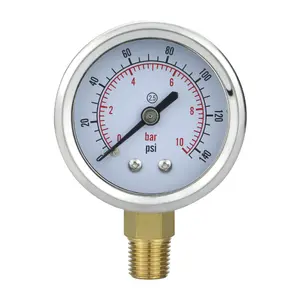

All Stainless Steel 200mm Pointer Dial Wate Liquid Pressure Gauge 1Mpa Boiler Pressure Measurement Dial Hydraulic Gauge


Pressure Guage 50mm Threaded Connection ZG1/4 2.5 Stainless Steel Liquid Filled Vacuum Pressure Gauge






A vacuum gauge measures the amount of rarefied vacuum pressure in contained environments down to an amount of absolute zero. Vacuum gauge models monitor vacuum levels in manufacturing, HVAC, research, and automotive applications. A digital vacuum gauge features like remote readout, alarms, and data logging help optimize vacuum processes and prevent potential technical failures. Precision vacuum monitoring with a vacuum gauge maximizes efficiency.
Traditional analog vacuum gauge options rely on mechanical bourdon tubes and dials for rudimentary monitoring. On the other hand, more modern digital vacuum gauge options deliver vacuum readings into a precise digital display for accurate psi and mbar measurements. No guessing or human error can occur from estimating needle positions with a digital vacuum gauge. The output of a digital vacuum gauge provides precise data for users. The digital precision and connectivity of a digital vacuum gauge also provide vacuum analysis that is not possible with traditional analog gauges.
High-end digital gauges measure from atmospheric pressure to ultra-high vacuums under 10^-3 mbar. Sensitive internal diaphragms on a digital vacuum gauge detect minute pressure fluctuations. The accurate digital readout from the vacuum gauge displays changes instantaneously to tenths or hundredths of a unit for better precision monitoring. A digital vacuum gauge's enhanced range and resolution optimize process control for faster monitoring.
Cutting-edge sensor technologies inside an automotive vacuum gauge improve responsiveness, consistency, and service life through its major design innovations. Silicon strain automobile vacuum gauge sensors prevent drift, while thermal compensation eliminates ambient temperature's impact on the gauge readings. The vibration resistance of a car vacuum gauge also maintains proper calibration through equipment vibration, and its sensors enhance reliability.
Instead of monitoring gauges locally, an engine vacuum gauge transmits pressure readings digitally to remote readouts and data logging software. The vacuum gauge allows centralized monitoring of multiple connected gauges across other equipment. Trend analysis of saved vacuum gauge data aids in predictive maintenance processes and overall efficiency optimization.
Programmable high and low vacuum gauge level alarms instantly alert technical operators if any processes end up deviating into danger zones. Audible and visual warnings on a vacuum gauge effectively protect equipment and prevent potential implosions from critically low vacuum levels. The sophisticated alarms of the vacuum gauge avoid catastrophic failures and accidents for the operators and users. Advanced digital vacuum gauge options with high sensitivity, alarms, and data handling deliver precision monitoring that is critical for optimizing specific processes.